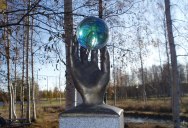In Sweden You’ll Find the World’s Largest Scale Model of the Solar System
by twistedsifter
Did you know the Sweden Solar System is the largest permanent scale model of the Solar System in the world? The Sun, represented by the Ericsson Globe in Stockholm, is the largest hemispherical building in the world. The inner planets can also be found in Stockholm but the outer planets are situated northward in other cities along the Baltic Sea. The system was started by Nils Brenning and Gösta Gahm and is on the scale of 1:20 million.
Let’s start our journey at our Sun and work our way outwards.
The Sun – Globen, Stockholm
Diameter: 71 m (solar disk) + the corona

The Globe Arena in Stockholm is the largest spherical building in the world, and it represents the Sun in the SSS. This picture shows the Globe lit by an animation, which included a sequence showing flares on the solar surface, during the inauguration of the International Year of Astronomy 2009. [source]
Mercury – Stockholm’s Stadsmuseum, Slussen
Diameter: 25 cm | Distance from Globen: 2.9 km

The model of Mercury is heated to symbolize its closeness to the Sun. Craters are depicted, and on the support structure various symbols are seen, like for the orbital drift in accordance with Einstein’s theory of relativity. [source]
Venus
Diameter: 62 cm | Distance from Globen: 5.5 km

Seen above was the original model of Venus located at Kungliga Tekniska Högskolan, Stockholm. Unfortunately the model was stolen in 2011. A new model of Venus, replacing the one stolen, is temporarily placed at the Institution for Space and Plasma Physics at the Kungliga Tekniska Högskolan, Stockholm. [source]
Earth/Moon
Cosmonova, Naturhistoriska riksmuseet, Stockholm
Diameter: 65 cm /18 cm | Distance from Globen: 7.6 km

The models of our planet Earth and the Moon are located outside the entrance of the space theatre Cosmonova at the Natural History Museum (in the ticket hall). [source]
Mars – Mörby centrum
Diameter: 35 cm | Distance from Globen: 11.6 km

Mars is connected to a plate in steel symbolizing the Earth. Chemical symbols for common compounds on Mars can be found on the sphere. [source]
Jupiter – Arlanda airport
Diameter: 7.3 m | Distance from Globen: 40 km

Jupiter was previously represented by an arrangement of flowers outside Sky City at Arlanda Airport. Plans for a new 3D model at another location are advancing. [source]
Saturn – Uppsala
Diameter: 6.1 m | Distance from Globen: 73 km

The planet Saturn will eventually crown a school planetarium in Uppsala. However, a first step was taken in 2010 when an artistic model of the moon Titan was inaugurated in central Uppsala at the Celsius House, where the 18th century astronomer Anders Celsius worked. In addition, several Saturn moons have been given form by pupils in school classes in the area. [source]
Uranus – Lövstabruk
Diameter: 2.6 m | Distance from Globen: 146 km

A symbolic and playful outdoor model of Uranus was inaugurated in Oct 2012 in Lövstabruk south of Gävle. The model was built in steel by Forsmark Mechanical Workshop at the Forsmark nuclear plant located close to Lövstabruk, and where the element Uranium plays an important role. The unusual tilt of Uranus’ axis is marked. [source]
Neptune – Söderhamn
Diameter: 2.5 m | Distance from Globen: 229 km

A sculpture of an asteroid discovered by A. Brandeker in 2000 with a telescope at the Stockholm Observatory, now ”Kunskapsskolan”, was unveiled in 2010. The object was named “Saltis”, after the nickname of Saltsjöbaden. [source]
Pluto – Delsbo
Diameter: 12 cm – Distance from Globen: 300 km

Pluto and Charon are supported by two tomb-like pillars reminding of the mythological meaning of Pluto (Hades), the god of the underworld. One can also be reminded of the meteorite impact that took place here 90 million years ago, when all life became extinct over a large area, and from which the Dellen lake system formed. Pluto is not classified as a planet anymore. It is a dwarf planet. [source]
Asteroid Saltis – Kunskapsskolan, Saltsjöbaden
Diameter: less than 1 mm | Distance from Globen: 17 km

A sculpture of an asteroid discovered by A. Brandeker in 2000 with a telescope at the Stockholm Observatory, now ”Kunskapsskolan”, was unveiled in 2010. The object was named “Saltis”, after the nickname of Saltsjöbaden. [source]
Halley’s comet – Balthazar, Skövde
Diameter: several depictions | Distance from Globen: 260 km

Comet Halley was inaugurated at the science centre Balthazar in Skövde on December 2009. Halley is represented by three outdoor models inspired by drawings made by school children. [source]
Ixion – Technichus, Härnösand
Diameter: 6.5 cm | Distance from Globen: 360 km

Ixion is one of the largest minor planets discovered by a team including Swedish scientists. The model is shown in the science centre Technicus in Söderhamn. [source]
Sedna – Teknikens hus, Luleå
Distance from Globen: 912 km

The model of the dwarf planet Sedna, created by Arto Koskitalo, was inaugurated in 2005 at the science centre ”Teknikens Hus” located in Luleå in northern Sweden, not far from the arctic circle. In arctic mythology, Sedna represented the ”goddess of the frozen sees” from where she supplied the Eskimos with seals and whales. Sedna is comparable to Pluto in size, and belongs to a distant swarm of minor planets called the Kuiper Belt. [source]
The termination shock – Institutet för rymdfysik, Kiruna
Diameter: N/A | Distance from Globen: 950 km

The distant interface between the solar wind and the surrounding galactic gas, the terminal shock, has been manifested in Kiruna. A future sculpture is envisioned to express this phenomenon reminiscent of aurorae frequently seen in northern Sweden. [source]
The Sweden Solar System


Sign up to get our BEST stories of the week straight to your inbox.




